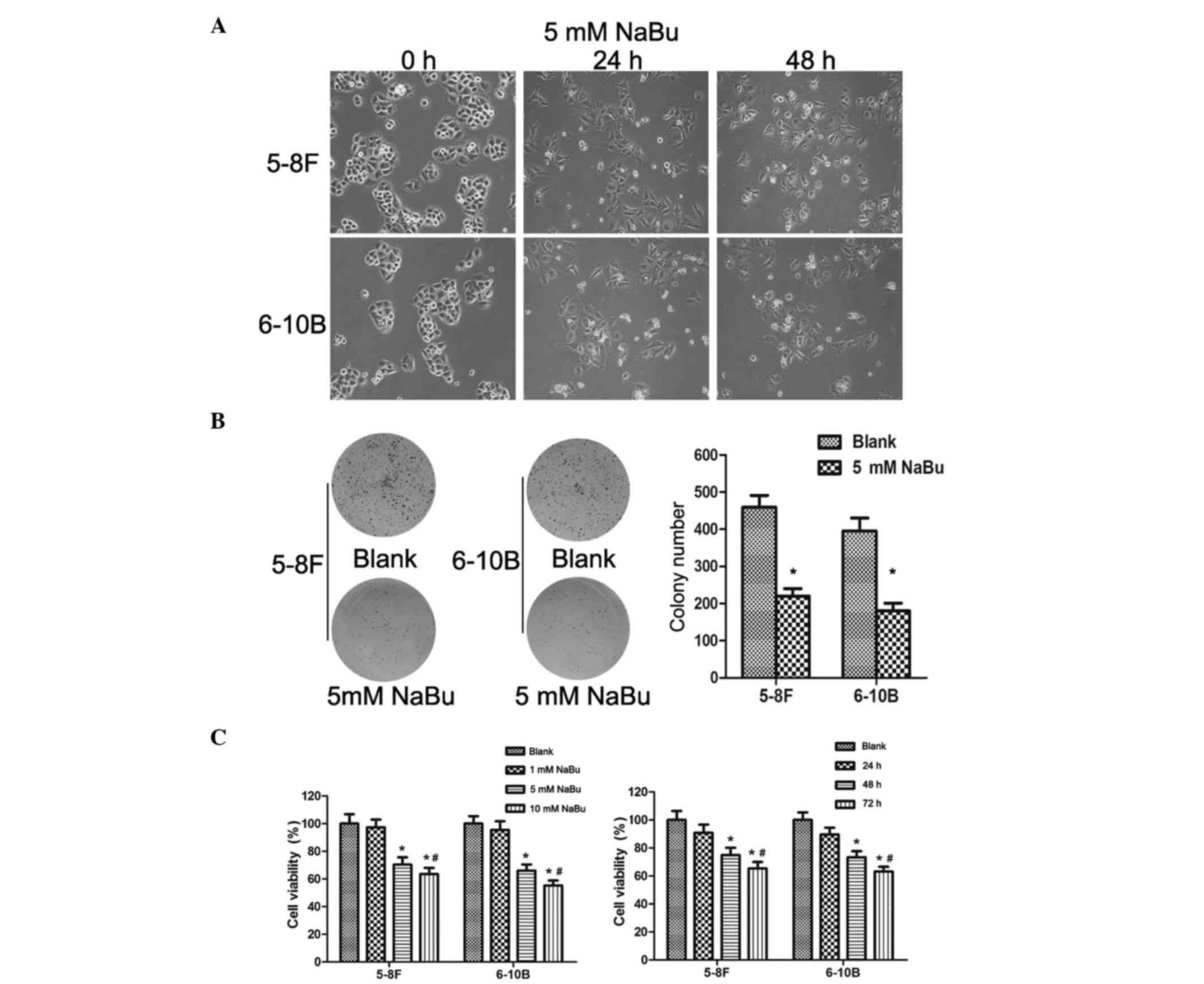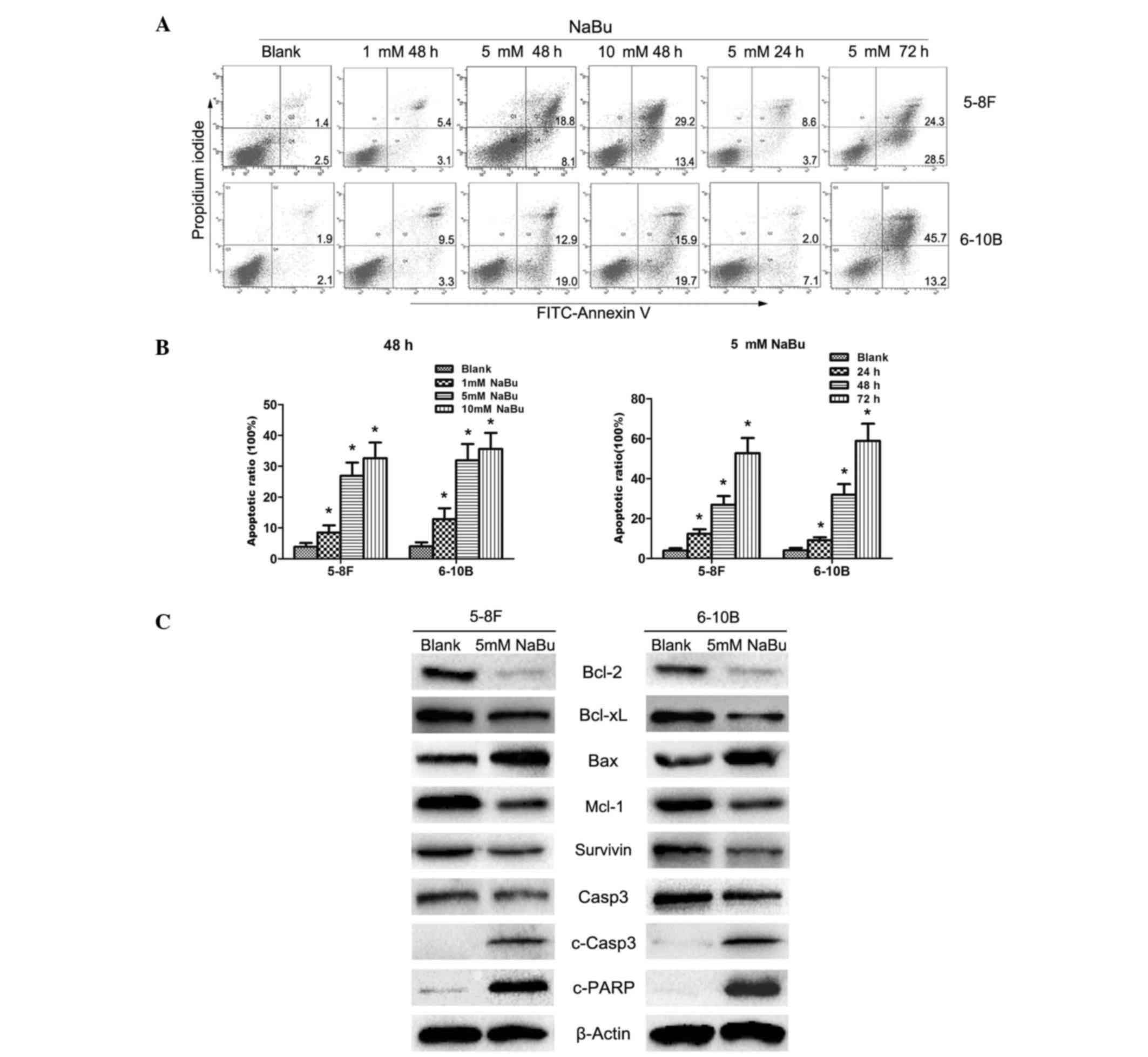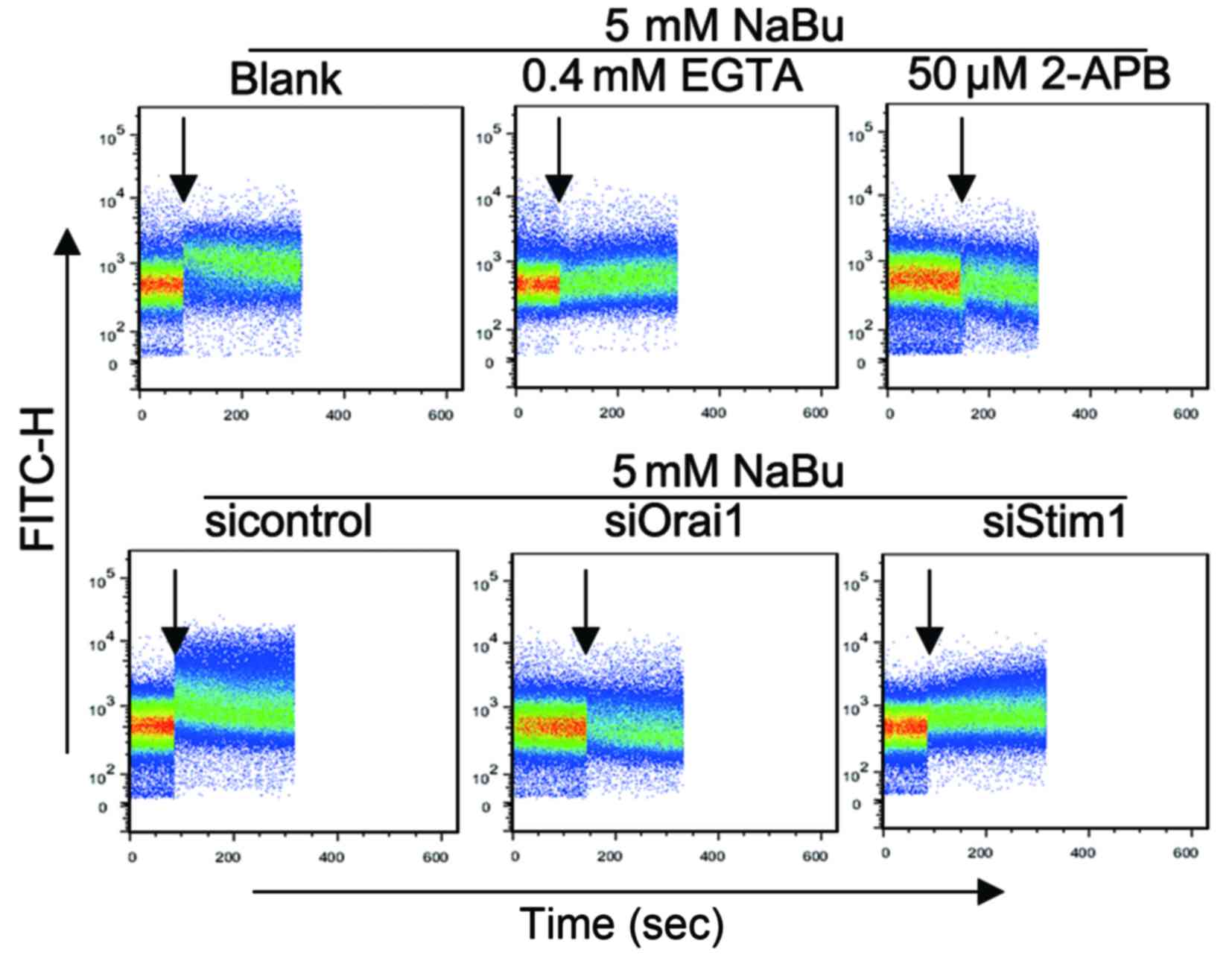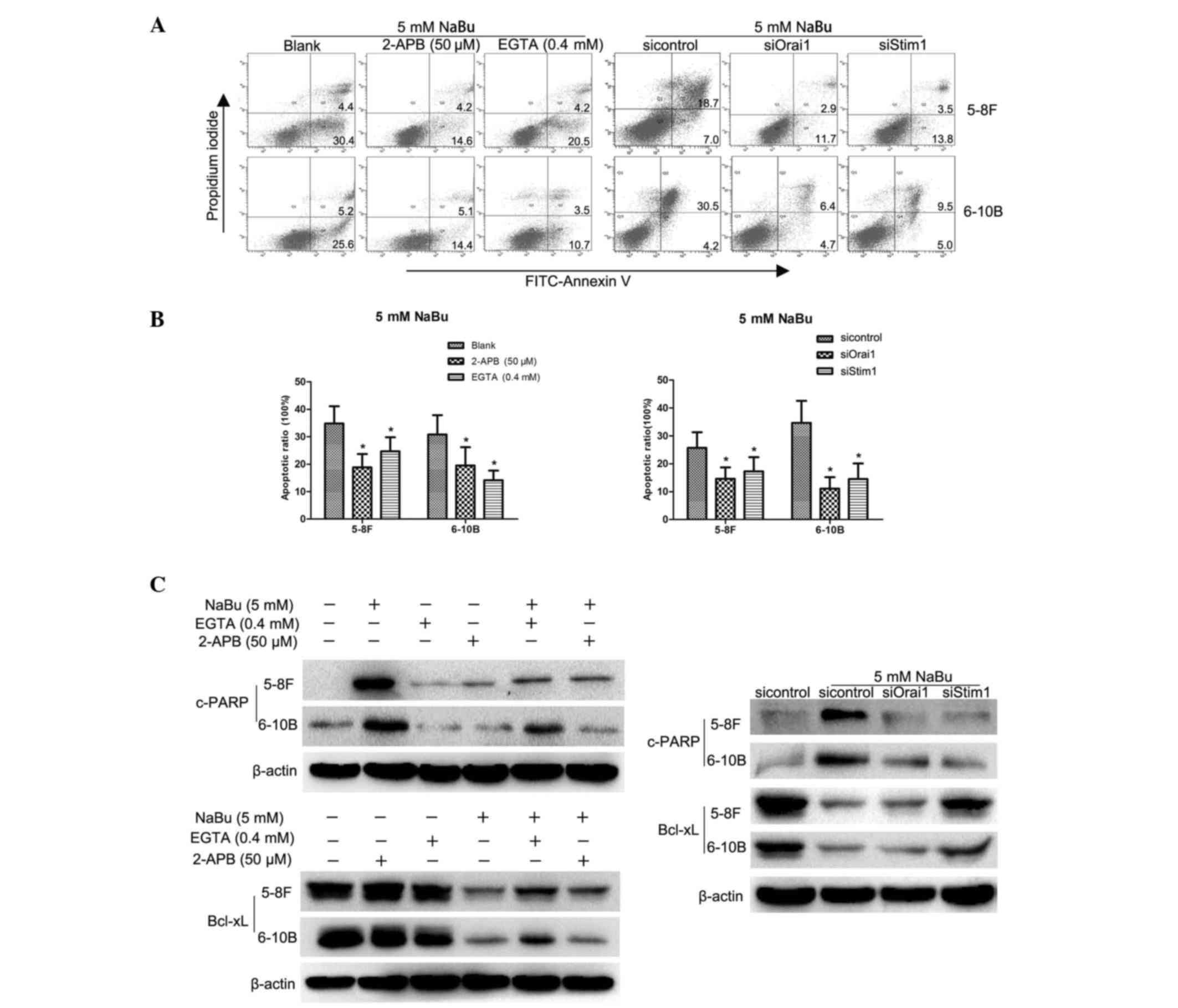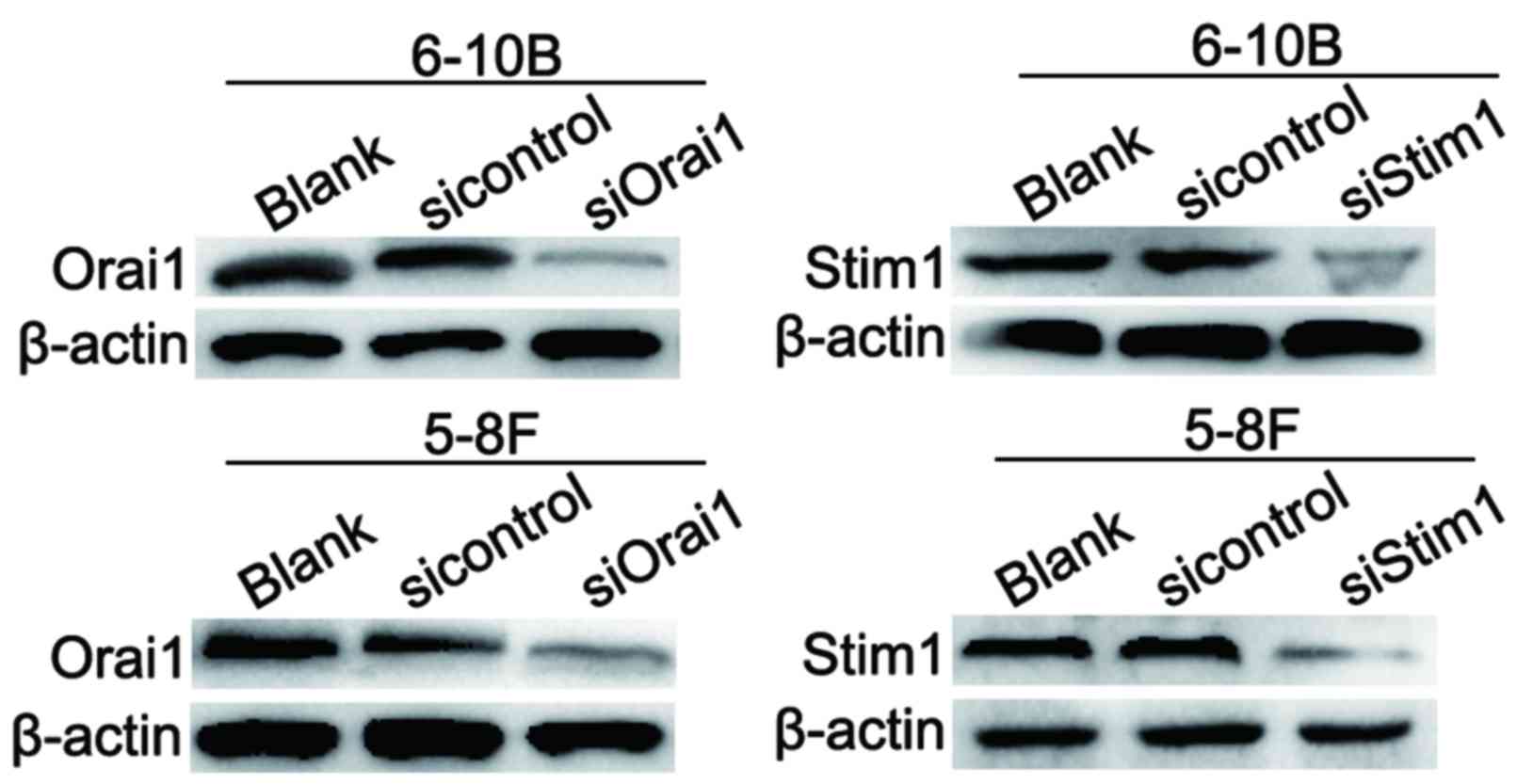Inhibition of store‑operated Ca2+ entry counteracts the apoptosis of nasopharyngeal carcinoma cells induced by sodium butyrate
- Authors:
- Published online on: December 7, 2016 https://doi.org/10.3892/ol.2016.5469
- Pages: 921-929
Abstract
Introduction
Nasopharyngeal carcinoma (NPC) is a malignant disease characterized by its unique geographic distribution, with Southern China and Southeast Asia holding the highest incidence rates, with an annual incidence of 15–50 cases per 100,000 people (1–4). The main etiological factors of NPC are genetic susceptibility, environment factors and Epstein-Barr virus infection (1). Radiotherapy is the recommended treatment for non-metastatic NPC at early stage due to its complex anatomic location and high radiosensitivity (5). Combined chemoradiotherapy is more effective in treating NPC patients with locally advanced stages or lymph node metastasis, which account for the majority of NPC types (3,4). Although the treatment results of NPC have improved in the past years, its overall survival (OS) rates at 5 years are still unsatisfactory (3). Thus, it is necessary and helpful to explore new agents that could achieve better therapeutic efficacy of NPC than the current ones.
Sodium butyrate (NaBu) is the sodium salt of butyric acid, one of the short chain fatty acids, which is naturally produced by symbiotic bacteria in the gastrointestinal tract through fermenting dietary fibers (6–8). Histone deacetylases (HDACs) are key epigenetic regulators that can regulate the gene expression profile by directly interacting with other proteins such as transcription factors (6). Their abnormal overexpression has been confirmed to contribute to carcinogenesis in multiple cancers (6). Therefore, HDAC inhibitors (HDACis) serve as a promising new class of anti-cancer tumor agents, and various agents of this type have been approved (6,8). NaBu, as a potent HDACi, has a great potential in cancer treatment and prevention (9). Its anti-tumor abilities, including proliferation inhibition and apoptosis induction (9), have been validated in several cancers, including colorectal cancer, prostate cancer, breast cancer and lung cancer (9–11). However, NaBu's influence on NPC cells has been rarely studied.
Ca2+ is a ubiquitous second messenger in signaling transduction, and the fluctuation of intracellular Ca2+ levels is involved in the regulation of multiple physiological functions, including cell growth, survival, apoptosis and migration (12). In non-excitable cells, store-operated Ca2+ entry (SOCE) is an important pathway for Ca2+ influx to refill the intracellular Ca2+ stores, mainly located in the endoplasmic reticulum (ER), which is mediated by the Ca2+ release-activated Ca2+ (CRAC) channel (13,14). Calcium release-activated calcium channel protein 1 (Orai1) and stromal interaction molecule 1 (Stim1) are two essential components of the CRAC channel (13,14). Upon activation, following oligomerization and translocation, Stim1, a single-pass transmembrane protein located in the membrane of ER, recruits Orai1, a cytomembrane protein, to form the functional CRAC channel, which stimulates Ca2+ influx (13,14). Under certain circumstances, including endogenous mutations and exogenous drugs stimulation, the Orai1/Stim1 CRAC channel may overexcite, and the aberrant overloaded intracellular Ca2+ concentration would cause a series of pathological responses such as apoptosis (15,16). Interrupting the SOCE process by knocking down Orai1/Stim1 or blocking it with specific inhibitors could counteract the apoptosis of cells induced by anti-tumor agents such as cisplatin, gypenosides and oxaliplatin in several cancers (7,15,16). SOCE was also confirmed to be necessary for the apoptosis induced by NaBu in colon cancer cells (17).
Thus, in the present study, various experiments were performed to test the anti-tumor efficacy of NaBu in NPC cells, and the roles of SOCE in NaBu-induced apoptosis in NPC cells were explored.
Materials and methods
Cell culture and transfection
The NPC cell lines 5–8F and 6–10B were obtained from the Cancer Research Institute of Sun Yat-sen University (Guangzhou, China). The cells were cultured in RPMI-1640 medium (Sigma-Aldrich; Merck Millipore, Darmstadt, Germany) supplemented with 10% fetal calf serum (Invitrogen; Thermo Fisher Scientific, Inc., Waltham, MA, USA) at 37°C in a humidified 5% CO2 atmosphere.
5-8F and 6–10B cells were transfected with small interefering RNA (siRNA) against Orai1 and Stim1 using Lipofectamine™ 2000 (Invitrogen; Thermo Fisher Scientific, Inc.) according to the manufacturer's protocol. Cells were collected for downstream analyses 48 h later,. The sequences of the siRNAs were listed elsewhere (18).
MTT assay
MTT (Sigma-Aldrich; Merck Millipore) assay was performed to evaluate the proliferation ability of 5–8F and 6–10B cells treated with NaBu. Cells were seeded at a density of 2,000 cells/well in 96-well plates with 200 µl culture medium containing NaBu at different concentrations. Then, the cells were consecutively cultured for 72 h. Every 24 h, 20 µl 5 mg/ml MTT solution was added into the corresponding well, and the cells were cultured for another 4 h. Then, the solution was replaced with 150 µl dimethylsulfoxide (Sigma-Aldrich; Merck Millipore), followed by gentle agitation of the plates for 15 min at room temperature. Finally, the absorbance at 492 nm was measured to represent the cell viability.
Colony formation assay
Colony formation assay was performed as described earlier (19). First, 5–8F and 6–10B cells were treated with 5 mM NaBu for 48 h. Then, the treated cells were trypsinized and seeded in 6-well plates at a density of 1,000 cells/well. Untreated 5–8F and 6–10B cells were also seeded in 6-well plates similarly. Eight days later, the cultured cells were fixed with paraformaldehyde and stained with crystal violet. Colonies containing ≥50 cells were counted under an inverse microscope (Nikon Corporation, Tokyo, Japan), and the colony formation ability was subsequently analyzed.
Apoptotic analysis by flow cytometry
Apoptotic analysis by flow cytometry was conducted using the Annexin V-FITC Apoptosis Detection kit (Vazyme, Piscataway, NJ, USA) according to the manufacturer's protocol. Briefly, 2×106 cells, both treated and untreated with NaBu, were collected and washed by pre-cooling PBS twice. Then, cells were resuspended in staining buffer and stained with 5 µl fluorescein isothiocyanate and 5 µl propidium iodide for 10 min in the dark at room temperature. Finally, the cell samples were analyzed by FACSCalibur (BD Biosciences, San Jose, CA, USA).
RNA extraction and reverse transcription-quantitative polymerase chain reaction (RT-qPCR)
RNA extraction and RT-qPCR were performed according to a previous procedure (2). Briefly, total RNA was extracted using TRIzol reagent (Invitrogen; Thermo Fisher Scientific, Inc.) and retrotranscribed into transcripts with the HiScript® II Q RT SuperMix for qPCR kit (Vazyme). Then, qPCR was conducted on a MJ Mini™ thermal cycler (Bio-Rad Laboratories, Inc., Hercules, CA, USA) using AceQ® qPCR SYBR® Green Master Mix (Vazyme). The qPCR cycle program was as follows: 95°C for 5 min, followed by 40 cycles at 94°C for 10 sec and 60°C for 30 sec. The relative messenger RNA expression levels of Orai1 and Stim1 were calculated using the 2−ΔΔCq method (20) following normalized to GAPDH. The primers for Orai1, Stim1 and GAPDH are listed in Table I.
Antibodies and western blotting
Rabbit anti-B-cell lymphoma (Bcl)-xL (cat. no. 10783-1-AP), anti-Bcl-2 (cat. no. 12789-1-AP), anti-caspase 3 (Casp3) (cat. no. 19677-1-AP), anti-Bcl-2-associated X protein (Bax) (cat. no. 23931-1-AP), anti-Orai1 (cat. no. 13130-1-AP), anti-Stim1 (cat. no. 11565-1-AP), anti-myeloid leukemia cell differentiation protein-1 (Mcl1) (cat. no. 16225-1-AP) and anti-survivin (cat. no. 10508-1-AP) polyclonal antibodies, and mouse anti-β-actin monoclonal antibody (cat. no. 66009-1-Ig), were all purchased from ProteinTech Group, Inc. (Chicago, IL, USA). Rabbit anti-cleaved (c)-Casp3 p17 (cat. no. D175) and c-poly ADP ribose polymerase (c-PARP) (cat. no. YC0101) polyclonal antibodies were purchased from ImmunoWay Biotechnology Company (Plano, TX, USA). Horseradish peroxidase (HRP)-conjugated anti-rabbit immunoglobulin G secondary antibody was purchased from Sigma-Aldrich (Merck Millipore).
Cells were disrupted with radioimmunoprecipitation assay buffer (Vazyme), and the supernatants containing total proteins were isolated by high-speed centrifugation at 4°C and 13,000 × g for 20 min. Then, the protein concentration was determined using the Pierce BCA Protein Assay kit (Thermo Fisher Scientific, Inc.) according to the manufacturer's protocol. Following separation by 12% SDS-PAGE (40 µg/lane), the proteins were electrophoretically transferred to polyvinylidene difluoride membranes using a wet transfer system (Bio-Rad Laboratories, Inc.). Subsequently, the membranes were subjected to blocking with milk, incubation with the primary antibodies (all 1:200 dilution) at 4°C overnight, and incubation with the secondary antibody (1:5,000 dilution) for 1 h at room temperature. Finally, the immunoreactive bands were developed with a chemiluminescent HRP substrate (Merck Millipore).
Intracellular Ca2+ measurements
Ca2+ measurements were conducted according to a published study (17). Briefly, the cells were collected and loaded with 5 µM Fluo 3-acetoxymethyl (AM) (Dojindo Molecular Technologies, Inc., Kumamoto, Japan) for 30 min at 37°C. After washing with Hanks' balanced salt solution (Ca2+ free) for three times, the cells were incubated at 37°C for another 20 min to allow de-esterification of Fluo 3-AM. Subsequently, the cells were treated with different combinations of agents and immediately subjected to flow cytometry analysis to detect the intracellular Ca2+ levels. 2-Aminoethoxydiphenyl borate (APB), a SOCE specific inhibitor, and ethylene glycol-bis(β-aminoethyl ether)-N,N,N',N'-tetraacetic acid (EGTA), a Ca2+ chelator, were both purchased from Sigma-Aldrich (Merck Millipore).
Statistical analyses
Statistical analyses were conducted with SPSS 18.0 statistical software (SPSS, Inc., Chicago, IL, USA) using the Student's t-test, and all the experiments were independently performed in triplicate. P<0.05 was considered to indicate a statistically significant difference.
Results
NaBu induces morphological changes and inhibits the proliferation of NPC cell lines
It has been demonstrated that NaBu can induce cell morphological changes in multiple cancers (21). In the present study, obvious morphological transformations induced by NaBu were observed in both 5–8F and 6–10B cells, as demonstrated by extended pseudopodia, enlarged and compressed cell size, and increased cellular vacuoles (Fig. 1A). These transformations exhibited a dose- and time-dependent pattern, since higher concentrations and longer time exposures led to bigger changes (Fig. 1A; dose-dependent results not shown). NaBu inhibited the proliferation of 5–8F and 6–10B cells remarkably, as demonstrated by the reduced number of cells and reduced size of the cell colonies in the colony formation assay (Fig. 1B).
NaBu decreases the cell viability of NPC cell lines in vitro
The cytotoxicity of NaBu has been confirmed in multiple cancer types (11,22,23). The present study explored the NaBu's cytotoxicity in NPC cells by MTT assay. 5–8F and 6–10B cells were treated with NaBu at different concentrations and exposure times. Under low concentrations (1 mM) and short exposure times (24 h), there were no significant differences in cell viability between the blank and the NaBu-treated group (Fig. 1C). However, the cytotoxicity of NaBu towards 5–8F and 6–10B cells increased with higher concentrations (5 and 10 mM) and longer exposure times (48 and 72 h) (Fig. 1C). Therefore, NaBu was cytotoxic to NPC cells, inducing a dose- and time-dependent decrease in cell viability, in both 5–8F and 6–10B cells.
NaBu induces NPC cells apoptosis by activating the mitochondrial pathway
Apoptotic induction is one of the common mechanisms responsible for the anti-tumor roles of NaBu (22,23). In the present study, obvious apoptosis was observed in 5–8F and 6–10B cells, as demonstrated by flow cytometry analysis (Fig. 2A and B). In accord with the results of the MTT assay, the apoptotic rate of NPC cells treated with NaBu also exhibited a dose- and time-dependent pattern (Fig. 2A and B). Subsequently, to identify the underlying mechanisms, the expression of proteins involved in the mitochondrial apoptosis pathway, an important signaling axis in apoptosis regulation, were detected. Downregulated expression of anti-apoptotic proteins, including Bcl-2, Bcl-xL, Mcl1 and survivin, was observed in 5–8F and 6–10B cells treated with 5 mM NaBu (Fig. 2C). Bax, one of the pro-apoptotic proteins, was downregulated in the NaBu-treated group (Fig. 2C). Furthermore, c-Casp3 and c-PARP, two of the apoptotic executors, were upregulated, while Casp3 was correspondingly downregulated in the NaBu-treated group (Fig. 2C). Taken together, these results indicate that NaBu could induce the apoptosis of NPC cells by activating the mitochondrial apoptosis pathway.
SOCE inhibition can attenuate the apoptosis induced by NaBu
Ca2+, as a key important second message, plays vital roles in cell signaling transduction processes such as apoptosis regulation (13). NaBu could activate the SOCE process in colon cancer cells to initiate apoptosis (17). In the present study, similar results were revealed in NPC cells. Influx of extracellular Ca2+ was observed in 5–8F cells immediately upon NaBu addition (Fig. 3), and similar outcomes were observed in 6–10B cells (data not shown). The Ca2+ influx was inhibited when EGTA, a Ca2+ chelator, or 2-APB, a SOCE inhibitor, were added together with NaBu. Correspondingly, the apoptosis induced by NaBu was attenuated by EGTA and 2-APB, as demonstrated by the lower apoptotic rates of the EGTA/2-APB-treated group compared with those of the NaBu alone-treated group (Fig. 4A and B), and by the increased levels of Bcl-xL and decreased levels of c-PARP in the EGTA/2-APB-treated group compared with those in the NaBu alone-treated group in western blot analysis (Fig. 4C). Therefore, the SOCE process may be involved in the NaBu-induced apoptosis of NPC cells.
Disruption of the CRAC channel can also attenuate the apoptosis induced by NaBu
The CRAC channel is one of the major pathways of SOCE progression (14). The present study successfully knocked down the expression of Orai1 and Stim1, two key components of the CRAC channel, in 5–8F and 6–10B cells (Fig. 5). Then, the Ca2+ influx induced by NaBu was analyzed, and it was observed that the Ca2+ influx was attenuated in 5–8F cells with downregulated Orai1 and Stim1 expression (Fig. 3). Similar results were obtained in 6–10B cells with downregulated Orai1 and Stim1 expression (data not shown). The apoptotic rates were decreased in NPC cells with downregulated Orai1 and Stim1 expression compared with those in the control group (Fig. 4A and B). Furthermore, the extent of fluctuations in Bcl-xL and c-PARP expression levels were decreased in NPC cells with downregulated Orai1 and Stim1 expression compared with those in the control group (Fig. 4C). Thus, based on the these results, the SOCE process appears to be necessary for the apoptosis induced by NaBu in NPC cells.
Discussion
It is well known that epigenetic aberrations contribute substantially to the onset and progression of human diseases, particularly cancers. HDACs, which are key epigenetic regulators, have been demonstrated to be involved in cancer progression (6,8). Overexpression of HDACs displayed a negative correlation with disease-free survival and OS, and could serve as a biomarker for prognosis prediction in multiple cancer types, including prostate (24), colorectal (25) and breast cancer (26). Thus, HDACis, which can inhibit the enzymatic activities of HDACs, are promising agents for cancer treatment. Currently, three HDACis, vorinostat, romidepsin and belinostat, have been approved for the treatment of cutaneous T-cell lymphoma and peripheral T-cell lymphoma (8).
NaBu, as a potent HDACi, has been confirmed to be capable of exerting anti-tumor roles in various cancers. For example, NaBu treatment could induce growth inhibition and morphological transformation in prostate cancer (21,23), breast cancer (27) and colorectal cancer (9). NaBu has been demonstrated to inhibit interferon-γ-induced indoleamine 2,3-dioxygenase expression in NPC cells (28). However, its cytotoxicity towards NPC cells was rarely studied. In the present study, NaBu exhibited significant cytotoxicity in NPC cells in a dose- and time-dependent manner, and inhibited their proliferation ability. Furthermore, NaBu treatment also induced morphological changes in NPC cells. Consequently, NaBu was concluded to be cytotoxic to NPC cells, in accordance with its known functions in other cancers.
Apoptosis induction is one of the common mechanisms of anti-tumor agents (29). Apparent cell apoptosis both through the death receptor (extrinsic)- and the mitochondrion (intrinsic)-mediated pathways, has been observed in multiple cancer cells treated with NaBu (9,22,30). For example, NaBu can activate mitochondrial apoptosis, as demonstrated by the expression changes in the Bcl-2 family of proteins, including upregulation of the pro-apoptotic Bcl-2 homologous antagonist/killer and Bax, and downregulation of the anti-apoptotic Bcl-2 and Bcl-xL (9). In the present study, flow cytometry analysis revealed that NaBu can also induce significant apoptosis in NPC cells. Furthermore, the decreased expression of anti-apoptotic proteins, including Bcl-2, Bcl-xL, Mcl-1 and survivin, in combination with the increased expression of pro-apoptotic proteins such as Bax and apoptotic executors such as c-Casp3 and c-PARP, confirmed the activation of the mitochondrial apoptosis axis in NPC cells treated with NaBu. Therefore, the present results revealed that the activation of mitochondrial apoptosis involves the anti-tumor roles of NaBu in NPC.
The important roles of Ca2+ and its ion channels in apoptotic regulation have been illustrated in numerous studies (31–33). A sustained increase in cytosolic Ca2+ activity triggers apoptosis (34). The roles of SOCE, a major calcium-entry pathway for non-excitable cells, and those of the CRAC channel, a key channel in mediating SOCE, in apoptotic regulation appear to be paradoxical (7,16,17,34,35). Indeed, SOCE can serve as a pro-apoptotic or an anti-apoptotic factor in cancerous cells under different conditions (7,16,17,34,35). For example, enhanced SOCE resulted from upregulated Orai1 and Stim1 expression, which was observed in drug-resistant cancer cells, and impairing SOCE by using specific inhibitors or by knocking down Orai1 and Stim1 can sensitize the drug-resistant cells to chemotherapy (34,35). In addition, enhanced SOCE commonly occurs during the cell apoptosis induced by anti-tumor or chemotherapeutic agents (17). The use of SOCE inhibitors or knocking down the expression of Orai1 or Stim1 can counteract the apoptosis induced by anti-tumor agents (7,16,17). In the present study, SOCE appeared to serve as a pro-apoptotic factor in NPC cells treated with NaBu, and inhibition of SOCE could attenuate the NaB-induced apoptosis in NPC cells, in accordance with previous results in colon cancer (17). Differences of SOCE in apoptosis may contribute to the dual roles of Ca2+ in signaling transduction: On one hand, a physiological Ca2+ concentration is necessary to activate signaling pathways that promote cell growth, survival and metastasis, which are the hallmarks of cancers; on the other hand, overloaded Ca2+ concentrations would also induce apoptosis through the activation of apoptotic pathways (12,13,31,33). Therefore, the anti-apoptotic role of enhanced SOCE in untreated cancer cells is to maintain their own characteristics, which must be regulated and controlled by upstream proteins (13,34). However, the enhanced SOCE observed in the pro-apoptosis of cancer cells treated with anti-tumor agents may be due to the impaired upstream control signaling disrupted by anti-tumor agents, which leads to a sustained increase in intracellular Ca2+ levels and triggers apoptosis.
In conclusion, the present study demonstrated that NaBu was able to trigger hyperactivated SOCE and subsequently induce the mitochondrial apoptosis pathway, which may underlie the mechanisms of its cytotoxicity on NPC cells. The results of the present study suggested that HDACis like NaBu may serve as promising chemotherapeutic or adjuvant chemotherapeutic agents in NPC therapy.
Acknowledgements
The present study was supported by the National Natural Science Foundation of China (Beijing, China; grant no. 81272972), the National Basic Research Program of China (Beijing, China; grant no. 2010CB833605), the Incubation Program for National Natural Science Funds for Distinguished Young Scholar of Central South University (Changsha, China; grant no. 2010QYZD006), the Hunan Provincial Science and Technology Department (Changsha, China; grant no. 2013FJ4010), the National Science Foundation of Hunan Province (grant no. 2016JJ2172) and the Open-End Fund for the Valuable and Precision Instruments of Central South University (Changsha, China; grant nos. CSUZC201634 and CSUZC201638).
References
|
Cao SM, Simons MJ and Qian CN: The prevalence and prevention of nasopharyngeal carcinoma in China. Chin J Cancer. 30:114–119. 2011. View Article : Google Scholar : PubMed/NCBI | |
|
Feng X, Ren C, Zhou W, Liu W, Zeng L, Li G, Wang L, Li M, Zhu B, Yao K and Jiang X: Promoter hypermethylation along with LOH, but not mutation, contributes to inactivation of DLC-1 in nasopharyngeal carcinoma. Mol Carcinog. 53:858–870. 2014. View Article : Google Scholar : PubMed/NCBI | |
|
Stoker SD, van Diessen JN, de Boer JP, Karakullukcu B, Leemans CR and Tan IB: Current treatment options for local residual nasopharyngeal carcinoma. Curr Treat Options Oncol. 14:475–491. 2013. View Article : Google Scholar : PubMed/NCBI | |
|
Zhang L, Chen QY, Liu H, Tang LQ and Mai HQ: Emerging treatment options for nasopharyngeal carcinoma. Drug Des Devel Ther. 7:37–52. 2013.PubMed/NCBI | |
|
Colaco RJ, Betts G, Donne A, Swindell R, Yap BK, Sykes AJ, Slevin NJ, Homer JJ and Lee LW: Nasopharyngeal carcinoma: A retrospective review of demographics, treatment and patient outcome in a single centre. Clin Oncol (R Coll Radiol). 25:171–177. 2013. View Article : Google Scholar : PubMed/NCBI | |
|
Falkenberg KJ and Johnstone RW: Histone deacetylases and their inhibitors in cancer, neurological diseases and immune disorders. Nat Rev Drug Discov. 13:673–691. 2014. View Article : Google Scholar : PubMed/NCBI | |
|
Sun DP, Li XX, Liu XL, Zhao D, Qiu FQ, Li Y and Ma P: Gypenosides induce apoptosis by ca2+ overload mediated by endoplasmic-reticulum and store-operated ca2+ channels in human hepatoma cells. Cancer Biother Radiopharm. 28:320–326. 2013. View Article : Google Scholar : PubMed/NCBI | |
|
West AC and Johnstone RW: New and emerging HDAC inhibitors for cancer treatment. J Clin Invest. 124:30–39. 2014. View Article : Google Scholar : PubMed/NCBI | |
|
Goncalves P and Martel F: Butyrate and colorectal cancer: The role of butyrate transport. Curr Drug Metab. 14:994–1008. 2013. View Article : Google Scholar : PubMed/NCBI | |
|
Tailor D, Hahm ER, Kale RK, Singh SV and Singh RP: Sodium butyrate induces DRP1-mediated mitochondrial fusion and apoptosis in human colorectal cancer cells. Mitochondrion. 16:55–64. 2014. View Article : Google Scholar : PubMed/NCBI | |
|
Wei ZL, Zhao QL, Yu DY, Hassan MA, Nomura T and Kondo T: Enhancement of sodium butyrate-induced cell death and apoptosis by X-irradiation in the human colorectal cancer cell line HCT 116. Oncol Rep. 20:397–403. 2008.PubMed/NCBI | |
|
Prevarskaya N, OuadidAhidouch H, Skryma R and Shuba Y: Remodelling of Ca2+ transport in cancer: How it contributes to cancer hallmarks? Philos Trans R Soc Lond B Biol Sci. 369:201300972014. View Article : Google Scholar : PubMed/NCBI | |
|
Chen YF, Chen YT, Chiu WT and Shen MR: Remodeling of calcium signaling in tumor progression. J Biomed Sci. 20:232013. View Article : Google Scholar : PubMed/NCBI | |
|
Bergmeier W, Weidinger C, Zee I and Feske S: Emerging roles of store-operated Ca2+ entry through STIM and ORAI proteins in immunity, hemostasis and cancer. Channels (Austin). 7:379–391. 2013. View Article : Google Scholar : PubMed/NCBI | |
|
Chiu WT, Tang MJ, Jao HC and Shen MR: Soft substrate up-regulates the interaction of STIM1 with store-operated Ca2+ channels that lead to normal epithelial cell apoptosis. Mol Biol Cell. 19:2220–2230. 2008. View Article : Google Scholar : PubMed/NCBI | |
|
Flourakis M, Lehen'kyi V, Beck B, Raphaël M, Vandenberghe M, Abeele FV, Roudbaraki M, Lepage G, Mauroy B, Romanin C, et al: Orai1 contributes to the establishment of an apoptosis-resistant phenotype in prostate cancer cells. Cell Death Dis. 1:e752010. View Article : Google Scholar : PubMed/NCBI | |
|
Sun S, Li W, Zhang H, Zha L, Xue Y, Wu X and Zou F: Requirement for store-operated calcium entry in sodium butyrate-induced apoptosis in human colon cancer cells. Biosci Rep. 32:83–90. 2012. View Article : Google Scholar : PubMed/NCBI | |
|
Yang S, Zhang JJ and Huang XY: Orai1 and STIM1 are critical for breast tumor cell migration and metastasis. Cancer Cell. 15:124–134. 2009. View Article : Google Scholar : PubMed/NCBI | |
|
Feng X, Li C, Liu W, Chen H, Zhou W, Wang L, Zhu B, Yao K, Jiang X and Ren C: DLC-1, a candidate tumor suppressor gene, inhibits the proliferation, migration and tumorigenicity of human nasopharyngeal carcinoma cells. Int J Oncol. 42:1973–1984. 2013.PubMed/NCBI | |
|
Livak KJ and Schmittgen TD: Analysis of relative gene expression data using real-time quantitative PCR and the 2(−Delta Delta C(T)) Method. Methods. 25:402–408. 2001. View Article : Google Scholar : PubMed/NCBI | |
|
Paskova L, Trtkova K Smesny, Fialova B, Benedikova A, Langova K and Kolar Z: Different effect of sodium butyrate on cancer and normal prostate cells. Toxicol in vitro. 27:1489–1495. 2013. View Article : Google Scholar : PubMed/NCBI | |
|
Maruyama T, Yamamoto S, Qiu J, Ueda Y, Suzuki T, Nojima M and Shima H: Apoptosis of bladder cancer by sodium butyrate and cisplatin. J Infect Chemother. 18:288–295. 2012. View Article : Google Scholar : PubMed/NCBI | |
|
Mu D, Gao Z, Guo H, Zhou G and Sun B: Sodium butyrate induces growth inhibition and apoptosis in human prostate cancer DU145 cells by up-regulation of the expression of annexin A1. PloS One. 8:e749222013. View Article : Google Scholar : PubMed/NCBI | |
|
Weichert W, Röske A, Gekeler V, Beckers T, Stephan C, Jung K, Fritzsche FR, Niesporek S, Denkert C, Dietel M and Kristiansen G: Histone deacetylases 1, 2 and 3 are highly expressed in prostate cancer and HDAC2 expression is associated with shorter PSA relapse time after radical prostatectomy. Br J Cancer. 98:604–610. 2008. View Article : Google Scholar : PubMed/NCBI | |
|
Weichert W, Röske A, Niesporek S, Noske A, Buckendahl AC, Dietel M, Gekeler V, Boehm M, Beckers T and Denkert C: Class I histone deacetylase expression has independent prognostic impact in human colorectal cancer: Specific role of class I histone deacetylases in vitro and in vivo. Clin Cancer Res. 14:1669–1677. 2008. View Article : Google Scholar : PubMed/NCBI | |
|
Krusche CA, Wülfing P, Kersting C, Vloet A, Böcker W, Kiesel L, Beier HM and Alfer J: Histone deacetylase-1 and −3 protein expression in human breast cancer: A tissue microarray analysis. Breast Cancer Res Treat. 90:15–23. 2005. View Article : Google Scholar : PubMed/NCBI | |
|
Sun B, Liu R, Xiao ZD and Zhu X: c-MET protects breast cancer cells from apoptosis induced by sodium butyrate. PloS One. 7:e301432012. View Article : Google Scholar : PubMed/NCBI | |
|
He YW, Wang HS, Zeng J, Fang X, Chen HY, Du J and Yang XY: Sodium butyrate inhibits interferon-gamma induced indoleamine 2,3-dioxygenase expression via STAT1 in nasopharyngeal carcinoma cells. Life sci. 93:509–515. 2013. View Article : Google Scholar : PubMed/NCBI | |
|
Dasari S and Tchounwou PB: Cisplatin in cancer therapy: Molecular mechanisms of action. Eur J Pharmacol. 740:364–378. 2014. View Article : Google Scholar : PubMed/NCBI | |
|
Gospodinov A, Popova S, Vassileva I and Anachkova B: The inhibitor of histone deacetylases sodium butyrate enhances the cytotoxicity of mitomycin C. Mol Cancer Ther. 11:2116–2126. 2012. View Article : Google Scholar : PubMed/NCBI | |
|
Pinton P, Giorgi C, Siviero R, Zecchini E and Rizzuto R: Calcium and apoptosis: ER-mitochondria Ca2+ transfer in the control of apoptosis. Oncogene. 27:6407–6418. 2008. View Article : Google Scholar : PubMed/NCBI | |
|
Rizzuto R, Pinton P, Ferrari D, Chami M, Szabadkai G, Magalhães PJ, Di Virgilio F and Pozzan T: Calcium and apoptosis: Facts and hypotheses. Oncogene. 22:8619–8627. 2003. View Article : Google Scholar : PubMed/NCBI | |
|
Prevarskaya N, Skryma R and Shuba Y: Targeting Ca2+ transport in cancer: Close reality or long perspective? Expert Opin Ther Targets. 17:225–241. 2013. View Article : Google Scholar : PubMed/NCBI | |
|
Schmidt S, Liu G, Liu G, Yang W, Honisch S, Pantelakos S, Stournaras C, Hönig A and Lang F: Enhanced Orai1 and STIM1 expression as well as store operated Ca2+ entry in therapy resistant ovary carcinoma cells. Oncotarget. 5:4799–4810. 2014. View Article : Google Scholar : PubMed/NCBI | |
|
Kondratska K, Kondratskyi A, Yassine M, Lemonnier L, Lepage G, Morabito A, Skryma R and Prevarskaya N: Orai1 and STIM1 mediate SOCE and contribute to apoptotic resistance of pancreatic adenocarcinoma. Biochim Biophys Acta. 1843:2263–2269. 2014. View Article : Google Scholar : PubMed/NCBI |



